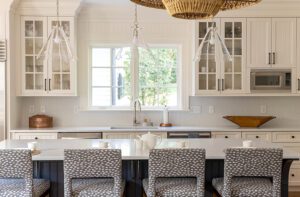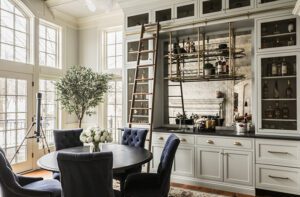Local Color
December 28, 2015
Text by Regina Cole Photography by Susan Teare

From Toronto to Japan to Boston, Vermont-based landscape architect has created some extraordinary gardens. A recent swimming pool project in southern Vermont demonstrates why she is in such demand. Nestled into a hillside below the main house, with a long view of mountains receding into the distance, the newly created terrace contains the pool, hot tub, a pool house, outdoor kitchen, fire pit, and dining areas. It provides space for family play and, thanks to the use of local stone and timber framing, it’s in perfect sync with the main house at the top of the hill. All the while, it delights the senses with beautiful stonework and carefully sited plantings.
“They used to swim in the pond,” Messervy says, as she traces the history of the complex. “But one of their grandchildren needed a cleaner environment, so they installed a swimming pool. For the homeowners, this is intended to be a grandchild paradise.”
The twenty-five-by-forty-foot shotcrete pool wears a veneer of hand-troweled black marcite plaster. “Here in Vermont, people want a less island, tropical look,” says Denise Rundle, who, with her brother and father, owns and operates Northeast Pools and Spas of Sharon, Vermont. “They don’t go for the bright blue, green, or white pools you see elsewhere. On a gray day, this pool looks black. When it’s a sunny day, it reflects some of the blue hue of the sky.”
Messervy explains that the scale of her design was driven by the grandeur of the backdrop. “With such a big view behind, we needed bigger water in the front, so the pool and all the stone and timber elements are oversized,” she says.
Surrounding the swimming pool is a terrace of Chester Stone, the local name for a lovely, shimmering mica schist.
“The mica lights up in the sun,” Messervy says.
“There is a vein of Chester Stone that runs through Proctorsville, Cavendish, and Chester, Vermont,” explains Greg Brown of Brown Masonry. “It has been quarried for many, many years.” He favors using local stone as often as possible, not just because it’s a greener option, but because it naturally suits the local aesthetic.
Local stone artist Dan Snow split the large pieces to make the flagstone pavers that form the pool deck.
Another variety of local stone forms the outdoor shower. “Hurricane Irene raised the level of the rivers so high that they dumped stone on people’s houses and in their yards, sometimes as deep as ten feet,” Brown recalls. “We call it ‘Irene Stone.’ It’s sold as fieldstone, but it’s soft and round, like river stone. That’s what Denver Schillinger, one of our talented masons, used on the outdoor shower and on the exterior of the pool house.”
Messervy based her design for the shower on the chinikana (pigeon hole) walls she saw at the Nishat Bagh gardens in Kashmir.
The pool house has a base of Irene Stone and is partially timber-framed with local white cedar, then crowned with a metal roof. A side door opens to an outdoor kitchen and dining area where a black granite dining table sits on a large slab of stone shaded by a pergola. Plantings of native species, including Joe Pye Weed, asters, purple coneflower, catmint, and meadowsweet, are augmented by blue and white hydrangea and potted annuals. The plants are sited to soften the hard edges and to frame the view.
Messervy strove to heighten year-round usability of the property. A case in point is a set of stone tracks leading from the main house to the pool deck next to the spa. “The homeowners want to use their hot tub in the winter, so I made an easy way for them to drive their all-terrain vehicle down there,” she explains.
Rundle marvels at how it all came together. “It took a huge amount of coordination between Greg Brown and me to create what Julie envisioned,” she says.
It was well worth it, Rundle believes. The results speak for themselves. •
Share
![NEH-Logo_Black[1] NEH-Logo_Black[1]](https://www.nehomemag.com/wp-content/uploads/2022/08/NEH-Logo_Black1-300x162.jpg)











You must be logged in to post a comment.